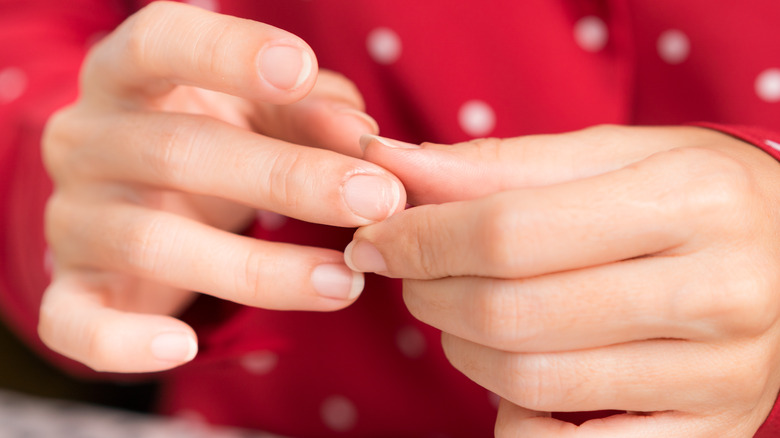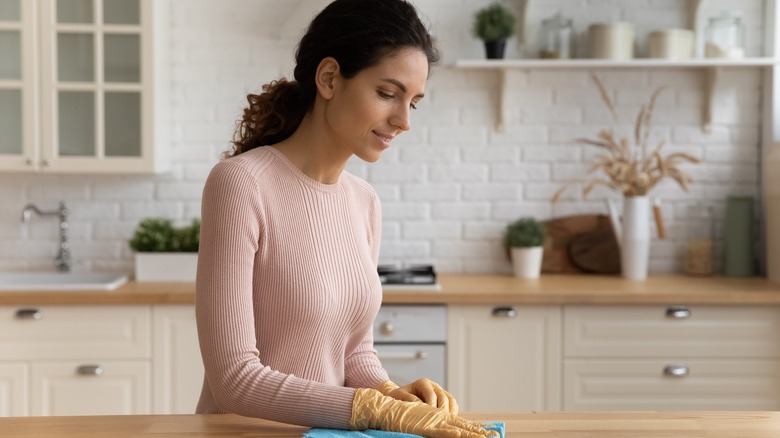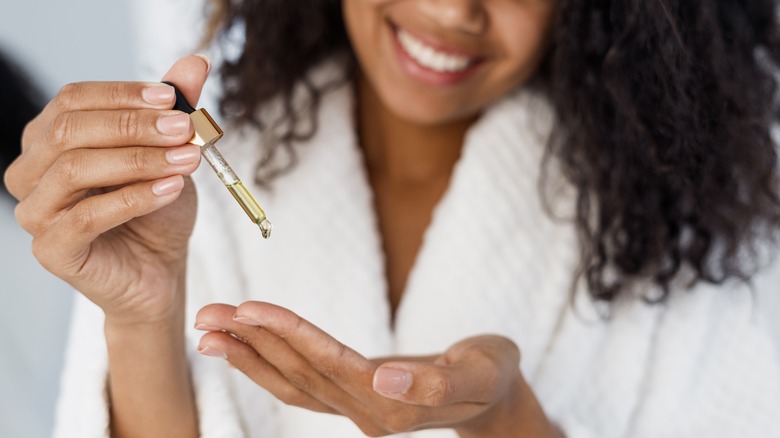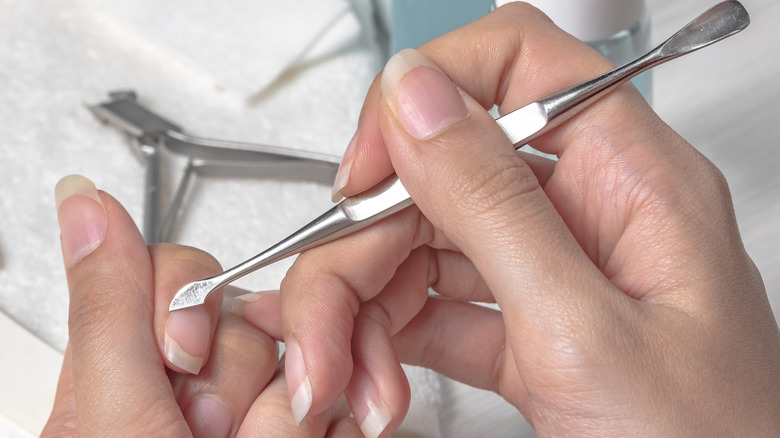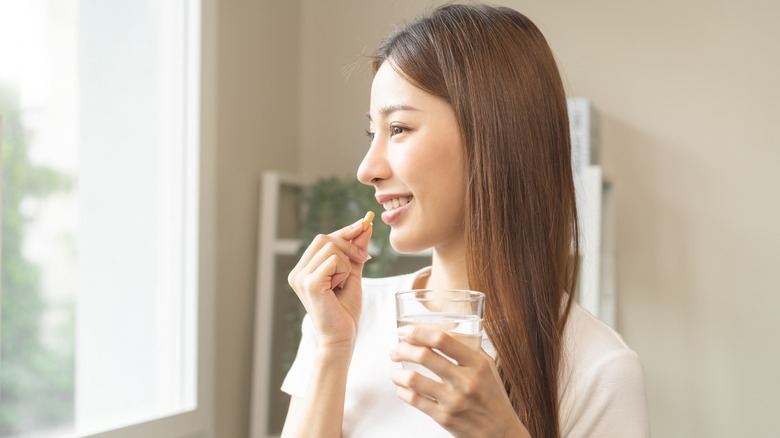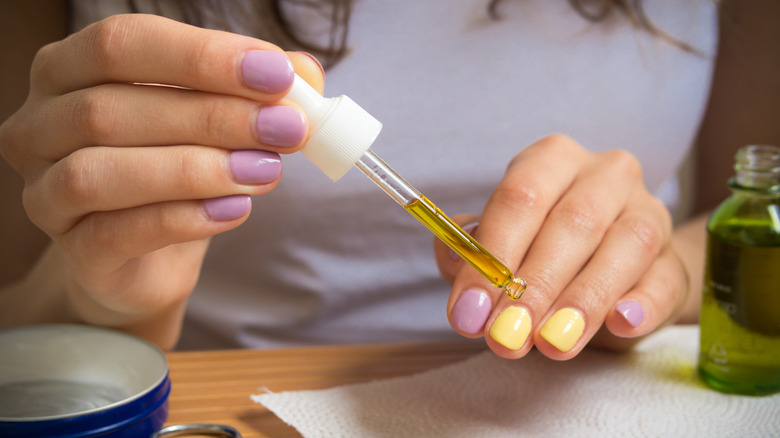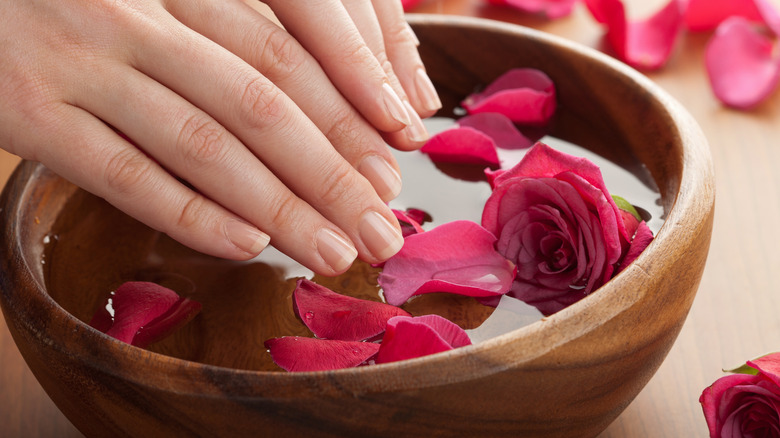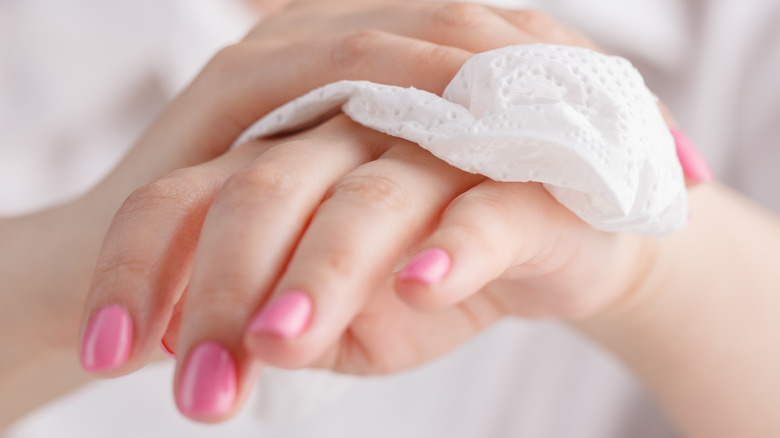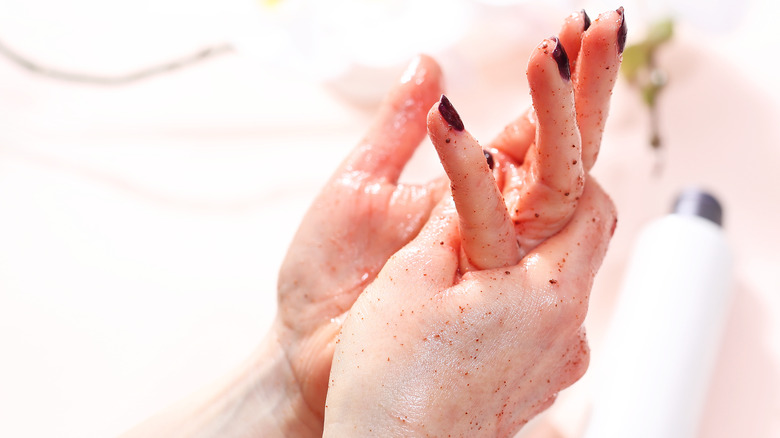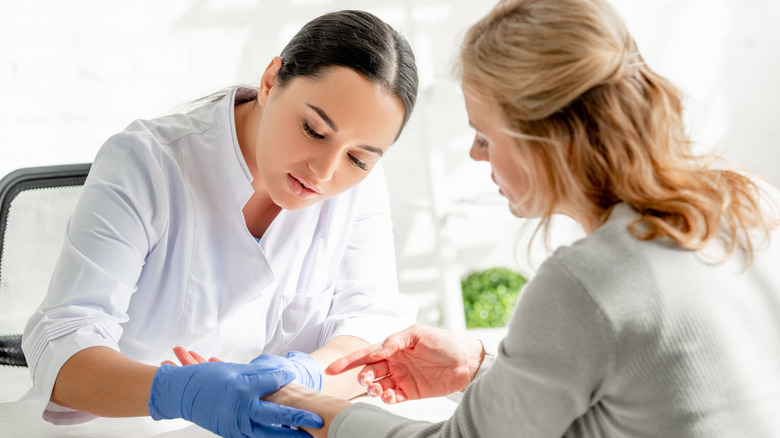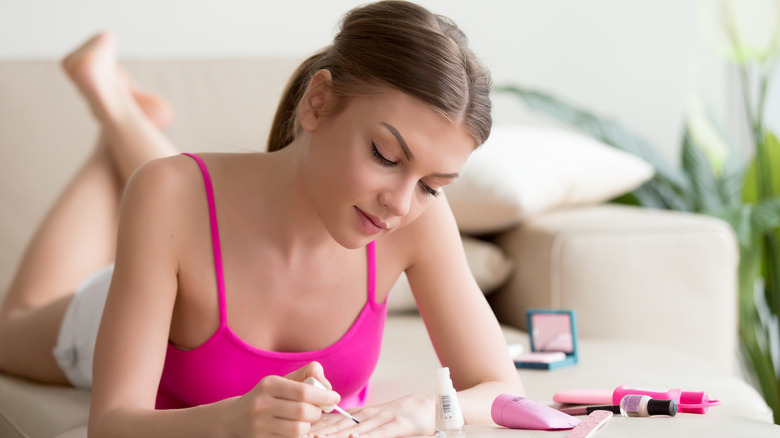15 Ways To Revive Your Dry Nails And Cuticles
Welcome to the real world, where you exit the salon completely overjoyed because your nails look amazing because, well, that's what salons are for. Give it some time, though, and eventually, your hands will revert back to the ol' familiar hands you've always known.
Do you love them, though? That's a whole other story because when your nails become dry and lackluster, and your cuticles are ragged, you'd rather be back in the salon giving them the VIP treatment they so desperately crave. Unfortunately, these are common issues that can plague your nails as a result of everyday habits, from washing your hands to doing the dishes.
While it's not always possible to head to a professional every single time your nails need some TLC, there are plenty of effective ways to treat common issues like dryness and peeling that may leave them looking less than fabulous. Here's how to give your dry nails and cuticles a new lease on life.
Use a hand moisturizer
Using moisturizer should be a part of your everyday routine as a habit. It's an easy way to ensure that your hands — and, of course, your nails — stay soft and healthy, and it can prevent common issues like dryness, cracking, and irritation. In fact, a study published by BMC Dermatology found that people who used hand cream after washing their hands experienced a significant decrease in "roughness." Some people may require more heavy-duty lotions if they wash their hands frequently. Something enriched with shea butter or argan oil makes an excellent choice since these deeply hydrating emollients sink into even the driest skin.
There are also products on the market formulated specifically to treat dry nails and cuticles. These aren't lotions in the conventional sense but "nail moisturizers" that are applied with a brush and massaged into the surrounding skin. Others have light serum-like consistencies that penetrate deeply to leave your nails softer with regular use. Many of these are enriched with nourishing vitamins and minerals that strengthen the integrity of your nails over time, leaving them less susceptible to dryness and more resilient overall.
Products containing occlusives like lanolin and beeswax may also be helpful. Dr. Clarissa Yang told CNN Underscored, "Occlusives are much more oil-based. They help by trapping the water the humectants draw up and preventing it from evaporating."
Wear gloves for protection
Whether your job calls for you to wash your hands frequently or you wash the dishes regularly, you might notice that your nails often bear the brunt. Not only do your hands become drier, but your nails appear brittle, and the skin around them may crack and break, leading to issues like cuts and painful hangnails. An easy way around this is to slip on a pair of gloves before you get started on your activity.
Some workplaces, like medical facilities and outdoor work sites, require gloves. Nurses, doctors, and other medical professionals wear disposable gloves for safety. If your hands and nails are particularly dry, look for medical varieties designed with moisturizing agents like aloe. They'll comfort your hands and nails while you work and give your hands some added protection when washing them again. If you work outdoors, opt for insulated gloves — you can apply moisturizer underneath to soothe chapped skin and keep your nails more resilient. Try everyday household gloves when cleaning up around the house or doing dishes.
Gloves can even be a part of your Thursday night self-care beauty routine! Apply your moisturizer of choice, then slip on a pair of soft cotton gloves. The fabric locks in moisture and allows the lotion to do its best work softening your skin and slowly eliminating dry spots, both on your nails and on your skin.
Apply products with vitamin E
Vitamin E is a skincare wonder. It's the type of powerhouse ingredient that people automatically think about when dealing with dry and uncomfortable skin. This is a big reason why it's considered the gold standard for treating dull and brittle nails and peeling cuticles. This rich oil has a thick consistency, so applying it to the skin can feel like a challenge. However, don't let that stop you — this viscous consistency is exactly what your dry nails and cuticles need right now.
And its benefits for your nails and cuticles are vast. Syreeta Aaron, an educator at LeChat Nails, explained to Ipsy, "Vitamin E oil also prevents cuticles from the cracking" and "can repair damaged nails due to polish or acrylics by nourishing and replenishing the nail to a healthier state." A note on that thick consistency: Most nail care products made with this nourishing vitamin have a bit more slip, making them easier to apply. You'll find a variety of choices, from moisturizers to cuticle balms.
Try to stop picking or biting your nails
Old habits die hard, and no one is going to blame you for feeling stressed and picking or nibbling at your nails or cuticles because, oh yeah, you're stressed out. We've all been there, and usually, stress has a way of unleashing itself in ways we don't exactly love. If your poor nails have seen better days, you may feel better about things knowing that this is a problem that is relatively easy to resolve.
First, the whys: Neuropsychologist Sanam Hafeez explained to Cosmopolitan, "Cuticle picking is a 'body-focused repetitive behavior,' which, in simple terms, means a repetitive self-grooming habit." She continued, "... people often pick their cuticles to relieve stress or when they're bored and fidgety."
Now, the hows: Find what works best for you. Ending your nail-biting habit may seem daunting, but it's possible. It might mean addressing what stresses you out and finding a new coping regimen to come out on the other side with a clearer head (and healthier cuticles). That's not to minimize the importance of your anxiety — it's super helpful to talk your feelings out with a therapist and develop coping mechanisms that help you feel your very best. From an aesthetic perspective, if you're swayed by the promise of beautiful nails, scheduling an occasional manicure at the salon may be all it takes to keep you away from your nails.
Watch for chemical exposure
The COVID-19 pandemic obviously saw an uptick in hand sanitizer usage, and it's possible that even with the worst of it in the rearview mirror, you still keep a bottle tucked in your purse at all times. While it's great to keep it handy when you aren't near soap and water, it's important not to overdo it. Using an alcohol-based sanitizer on already weak nails could make that damage even worse.
Then there's the effect that acetone in your nail polish remover may have on both nails and skin. This chemical behaves like a solvent, cutting through nail polish so you can easily wipe it off. While your body will filter out any acetone that your skin absorbs while you remove your nail polish, it is possible for it to irritate the surrounding skin and potentially cause it to become dry and cracked. This is medically known as dermatitis. Harvard Health Publishing notes that "less contact time" with acetone — in other words, removing your polish quickly — "may mean less damage to the nail plate, skin, and cuticles."
Avoid cutting your cuticles
Getting a manicure is a simple joy that can bring great pleasure. Who doesn't love a little time out for some very necessary self-care? At the same time, many manicurists cut cuticles, which can be a harsh wake-up call for your nails. Cuticles are there for a reason — to serve as a protective layer between the skin and the nail. Removing that seal could easily invite bacteria into the space and lead to a painful infection. You can avoid this drama simply by requesting that your technician not trim your cuticles.
If it's a part of your routine, though, make sure that the cutting tool used to trim is adequately sterilized. This can minimize the chances of developing an infection. The tool should also be sharp, as a tool that is less defined could actually worsen the condition of the cuticles by causing them to peel, per Healthline.
Support your nails with vitamins
What you put into your body really influences how you look and feel — including how your nails appear. They rely on a host of vitamins and minerals to remain strong and resilient and to support the development of healthy new cells and tissue growth. According to Healthline, among the most important is biotin, a type of "B-complex" that supports amino acids, or the building blocks of protein, to keep your nails long and strong.
Iron is equally essential because it delivers oxygen to your nails. If you're anemic, your nails are starved for oxygen, which can lead to a condition that causes "vertical ridges" to develop on the nails. Your nails can even become shinier and look better if you consume more omega-3 fatty acids. This important healthy fat can decrease any inflammation levels in the body, in turn supporting healthier cell development and lending your nails a softer texture and a rosier color.
Replenish nails with different oils
Lotions are great, but sometimes a potion is needed to give your nails and cuticles the TLC they so desperately need. Oils are incredibly light yet highly absorbent. Your nails and cuticles essentially drink them right up, resulting in surfaces that feel softer than ever. In fact, a great majority of nail care products are oil-based, with common sources including coconut, argan, and jojoba.
These are popular because they're enriched with a high level of moisturizing fatty acids and anti-aging antioxidants. Some can even help prevent infections. Essential oils with natural ingredients are also touted as healing emollients for distressed nails and cuticles. For example, lavender is considered a "fortifying" oil, per New Directions Aromatics, and may strengthen the nails and make them more resilient. Rosemary can restore shine to dehydrated nails, while frankincense can moisturize while reducing peeling skin around them.
Adopt a regimen for dryness
If you don't tackle your dry hands head-on, the problem may simply worsen. Once upon a time, it might have been enough to slather on some good moisturizer. However, the more that dryness increases, the worse your nails and cuticles will look and feel. Adopting an anti-dryness regimen is one of the most effective ways to relieve discomfort. What is the best place to begin? The cuticles.
Olivia Van Iderstine, a mani trend expert from Olive & June, told Martha Stewart, "Nail health starts with the cuticles — even a perfectly polished manicure can't save cuticles that are ragged and dehydrated." Using a dedicated moisturizer, be it an oil or a cream, on your cuticles is a good starting point.
Elevate your overall hand care routine, too. Use moisturizer after every wash if possible. Wearing a hand mask is another great way to resolve the discomfort associated with extra-dry skin and nails. Because they're left on for an extended period, the gloves impart deep moisture that your hands will drink up.
Minimize frequent water exposure
Yes, washing your hands is necessary, but keep in mind that overdoing it could be harming your nails. Jan Arnold, who founded Creative Nail Design, told The New York Times that it all relates to the nail's structure, which is made up of several layers with spaces in between them. "If those pockets get filled with air or water, it swells the space and causes the nail plate layers to break apart and delaminate," she explained.
So while it is indeed important to wash your hands, you should do your best to limit it if it's not absolutely essential to do so. Nails dehydrate faster than skin, so constant exposure to soap and water can leave them drier and drier, until they become weak and brittle. It's not just your nails that pay the price, either — your cuticles also suffer as a result.
Exfoliate your nails and cuticles
Scrubbing your nails and cuticles may not exactly be a part of your everyday routine, but you're about to wonder why you didn't start sooner. Just like regular exfoliating is a great way to slough away dead skin cells and leave your skin softer, brighter, and more radiant, so too is the fine art of nail exfoliation.
The reason is simple, according to dermatologist Dana Stern. She told Well + Good, "Your nails have layers of dead nail cells — AKA onychocytes — that become dehydrated and damaged from environmental exposures such as water, temperature changes, as well as chemicals from products, polish remover being the biggest culprit." She added that when the onychocytes "lift and separate," the nails peel and become weaker.
Luckily, scrubbing isn't a complicated process. You can gently do so with a nail file or buffer. A regular body scrub made with natural ingredients, like baking soda or ground walnuts, is also a great option. Chemical-based products are also available, but it's best to avoid these if your nails are already dried out, and you're ready to restore them to their former glory.
Take a manicure break
Repeat after us: No more manicures — at least temporarily. It's not exactly music to your ears, we know, but there's a very good reason to skip them for now, as it allows your nails and cuticles time to heal. Manicures are amazing, but they're quite involved. Once the nail polish is on, eventually, it will need to come off. That may call for a damaging acetone remover, although there are much friendlier alternatives out there.
Jin Soon Choi, a celebrity manicurist, shared with Footfiles that wearing nail polish for a long time could even cause an issue known as keratin granulation. This condition leads to "rough, white patches" that develop after the polish removal process. Giving your nails a little manicure break is just the right thing to do so they'll be in great shape the next time you add a little fresh paint to your tips.
Consider adjusting your diet
Yes, what you eat can absolutely affect your nails! It's not only what you eat but also how much you consume. According to Erica Drewry, the owner of Aligned Nutrition, your body will eventually pay the price if you don't take in enough nutrients. "... if you aren't eating enough, all of the less-vital bodily processes will suffer. Your body will prioritize your major organ systems and neglect nails (and hair and skin)," she told Who What Wear.
So, what's a dry-and brittle-nailed person to do? Give your diet a nutrient boost, focusing on the vitamins and minerals that are known to strengthen nails. Biotin is found in a variety of foods, including salmon, sweet potato, and cauliflower. You can get some iron from dark, leafy vegetables, beef, and chicken. You can also add something with vitamin C, like an orange, to improve your body's ability to absorb the iron for best results.
See your dermatologist
Your nails can tell you a lot about your health — and sometimes the answer isn't as simple as slathering on an oil or a cream. Some people who live with autoimmune disorders, like psoriasis, experience issues with their nails. Some common symptoms include dents and long horizontal lines on the nails, and the skin around the nails may become dry and difficult to manage without prescription medication.
If you suspect that you may have nail psoriasis or the dryness of your nails and cuticles persists despite your best efforts, it's a good idea to see your dermatologist. They can thoroughly examine your skin and analyze the condition and appearance of your nails to determine whether treatment is necessary. Luckily, many people respond very well to conventional psoriasis solutions like corticosteroids and injectable medications. Per Healthline, patients with more severe cases might respond best to an oral medication.
Try different polish removal methods
It would seem like using acetone is the only way to remove nail polish, but that's not the case. There are non-acetone formulas available that are far gentler on your nails and skin — but may take more time to break down the polish. Luckily, other alternatives are far less harsh overall. The first step, no matter what method you use, is to dunk your nails in warm water to soften your nails and cuticles. That will make it easier for the polish to come off.
An interesting nail polish alternative is to combine equal parts orange juice and white vinegar. Shake the blend, pour some out on a cotton pad, and press it down on each fingernail for at least 10 seconds. This will help the polish soften, so it's easy to wipe off. If you'd rather try something off the shelf, a formula made with soy is a newly popular alternative to non-acetone. It takes longer to do the job, but the health of your nails and cuticles is definitely worth it.
